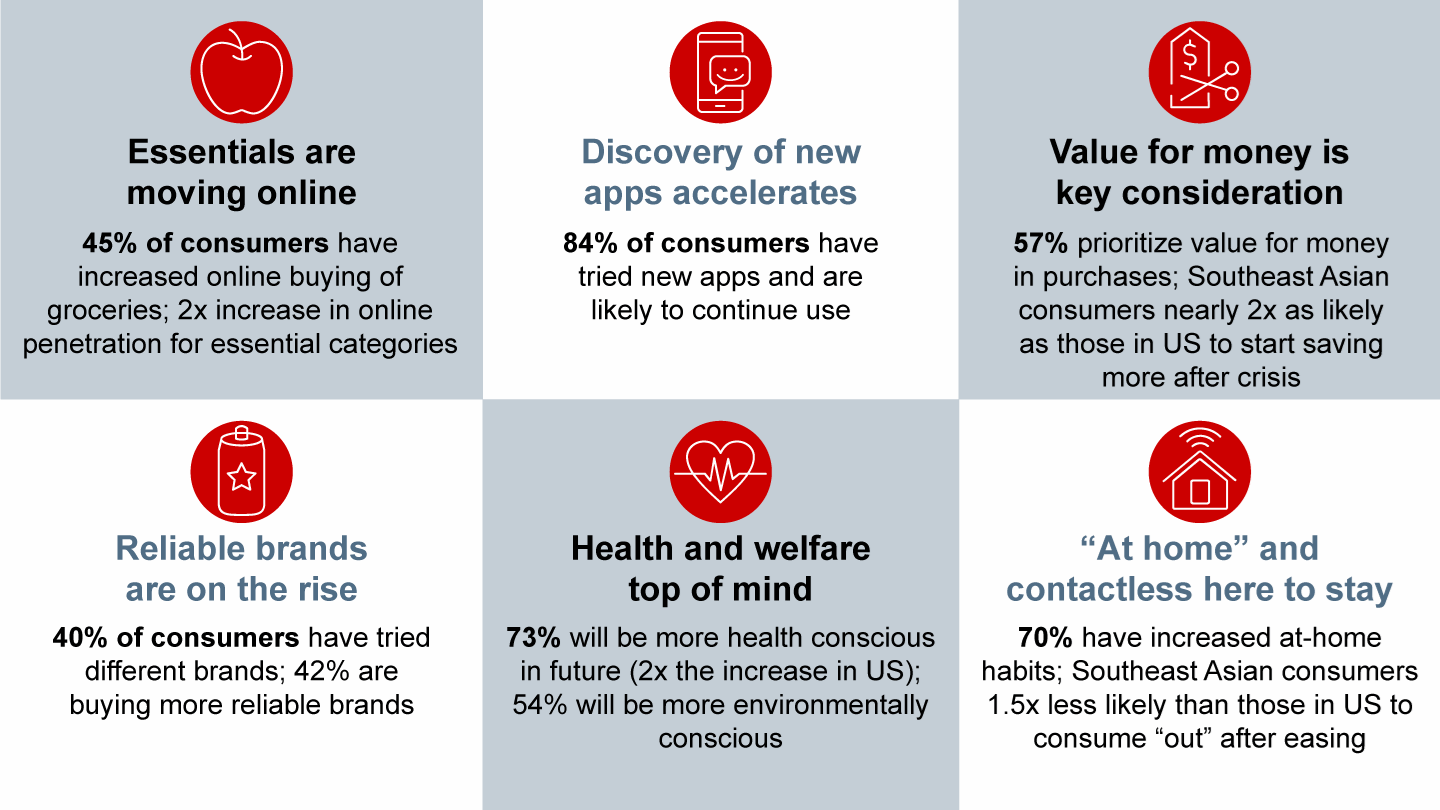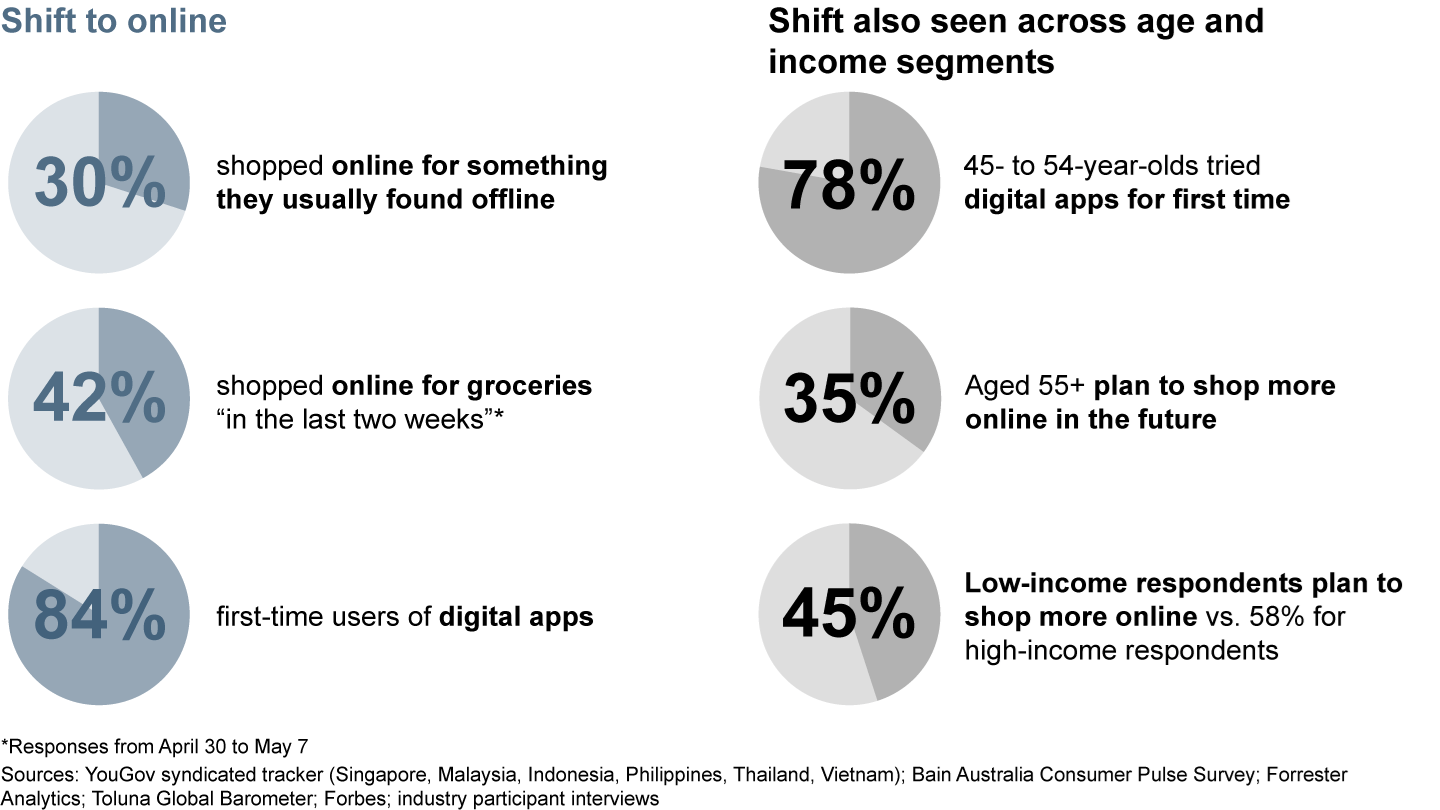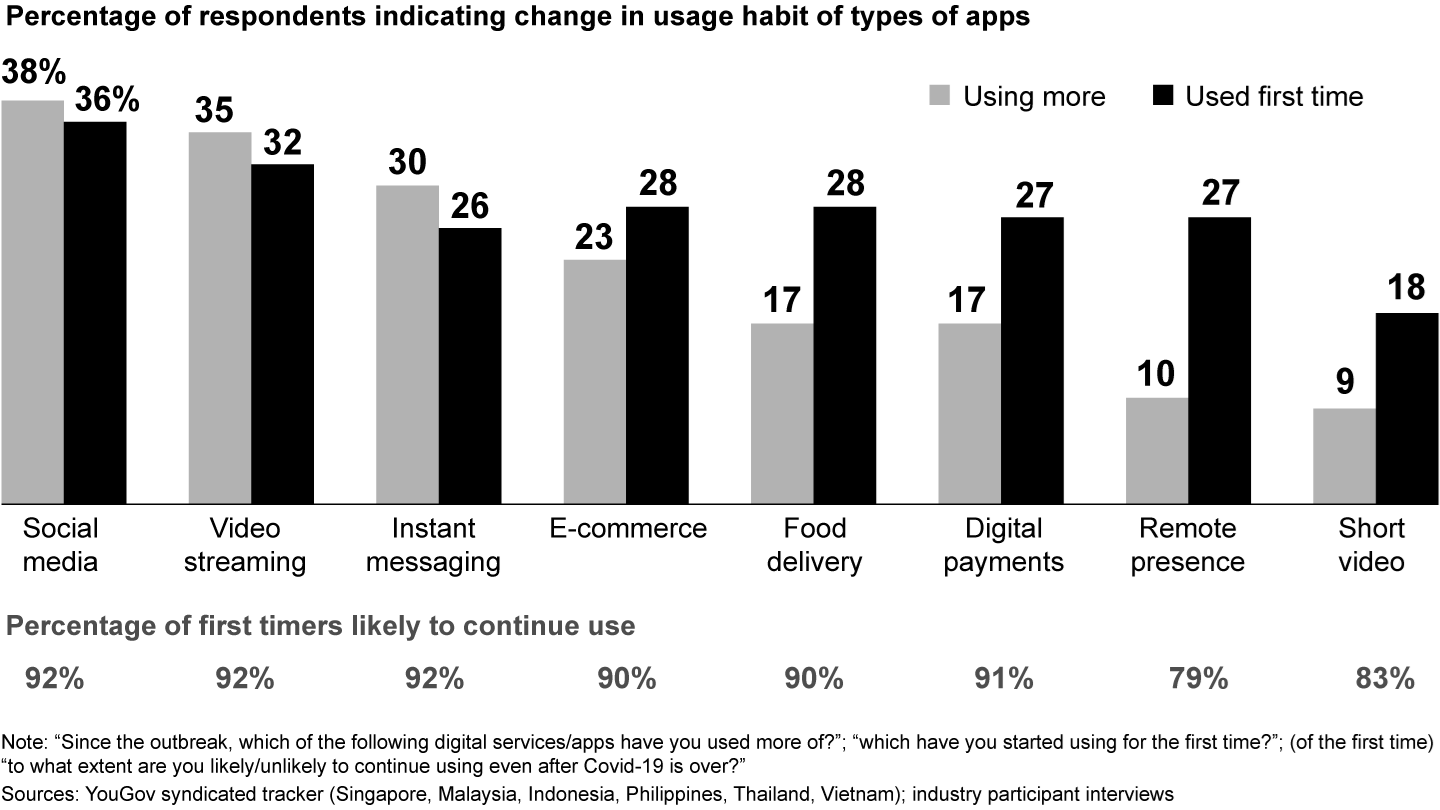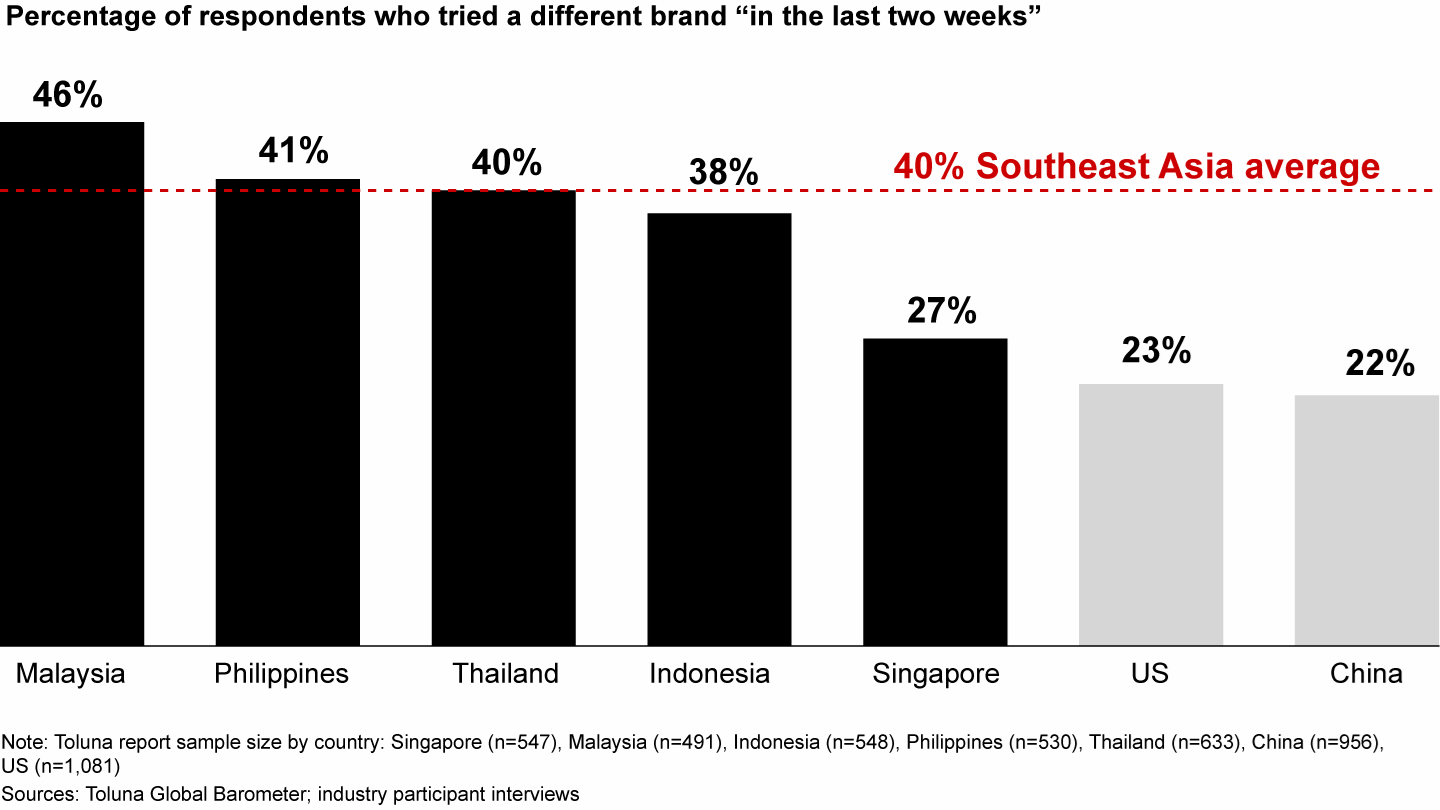Report

Executive Summary
- As part of a continuing Bain and Facebook study on the growth of digital consumer behavior, we analyzed the buying patterns of 8,600 digital consumers in six Southeast Asian countries over the past six months, learning that while 47% of consumers decreased offline purchases, 30% increased their online spending.
- Among other findings, the region’s digital consumers expect to spend more time at home after restrictions are lifted, and they have discovered new apps that they intend to continue using. They are buying more essentials online, delaying splurge spending and are favoring value for money and trusted, established brands.
- Consumer goods companies are responding by swiftly increasing product availability and visibility online, targeting digital engagement across platforms and optimizing pricing and value perception.
While Covid-19 may be among the most devastating of all black swan events to hit Southeast Asia, it by no means is the first—and like previous crises in the world, it is introducing long-lasting changes to consumer behavior and digital adoption.
The SARS epidemic triggered e-commerce in China. The global financial crisis spurred the shared economy and service marketplaces, first in the US and then globally. MERS boosted e-commerce in South Korea. Now, Covid-19 is moving consumers online faster than consumer goods companies thought was possible. Among the biggest consequences: The pandemic is hastening development of digital ecosystems in which consumer goods companies partner with food delivery services, online marketplaces, gaming companies or others for everyone’s benefit. It also is showing businesses how to adapt their playbooks—and some are making the thoughtful, agile moves that will help them maintain strong footing both today and for a post-Covid world.
Bain and Facebook have been studying the exponential growth of digital consumer behavior in Southeast Asia for three years. As we move into the second half of 2020 and the next normal, we examine what has changed and what hasn’t changed, and we consider what the future will look like for companies.
Covid-19 is intensifying the move online and serving as a catalyst for important changes. Online purchasing, digital consumption and average online basket size all have risen substantially and will continue to grow at record-setting rates, providing an opportunity for traditional businesses, large marketplaces and disruptive business models to thrive.
Virtually overnight, Covid-19 has led consumers to alter their spending habits. Worried consumers stockpiled basic goods, looking for value and trusted brands. They cut back on apparel and consumer electronics. And, in record numbers, they started buying online. Our analysis of buying patterns of 8,600 consumers in six Southeast Asian countries found that while 47% of consumers decreased offline purchases, 30% increased their online spending.
Our analysis helped us identify six critical themes in Southeast Asia among digital consumers who have made purchases online in the last six months (see Figure 1).
We identified six emerging consumption themes


Essentials are moving online. Whether they are quarantined or fearful of contact with others, consumers across Southeast Asia are spending more online during the pandemic. Among those surveyed in late April and early May, 42% had shopped online for groceries in the previous two weeks (see Figure 2). Essential goods such as fresh or packaged grocery account for many of their purchases. Having shifted online, many now anticipate they will continue relying on e-commerce after the crisis ends; roughly 83% of those shopping online say they are likely to continue their increased spending online after restrictions are lifted.
Consumers make dramatic shifts to online during Covid-19 pandemic


Discovery of new apps accelerates. Southeast Asia’s consumers have never been shy about trying new apps. The Philippines is the world leader in volume of text messaging. Jakarta has traditionally sent more tweets than New York, Tokyo, London or São Paulo. The pandemic has opened the region’s consumers up to more options. For example, 28% of respondents tried a new e-commerce app and 27% tried a new digital payments app (see Figure 3). Moreover, 77% of surveyed digital consumers tried a new app that they plan to continue using post-Covid-19. This focused interest in digital options cuts across age groups and has caused companies to respond. For example, with more consumers using social media apps, social commerce is flourishing.
Southeast Asia’s consumers are trying more apps


Value for money is a key consideration. Facing economic uncertainty, digital consumers now are more thoughtful about the purchases they make. As they stockpile or plan for an unstable future, they know what they want to buy and are turning their backs on splurges and impulsive spending. Value for money is a key purchase criterion for 57% of Southeast Asia’s digital consumers. An average 60% of the region’s digital consumers say they plan to save more money in the future—a rate nearly twice that of digital consumers in the US.
Reliable brands are on the rise. Southeast Asia’s digital consumers have always been open to trying new brands, with purchasing habits largely inspired by an openness to digital discovery. This year we looked closely at the types of brands these consumers buy and learned that they showed a strong preference for trusted and established brands. Forty-two percent said they had bought more established brands in recent months. Established brands have the consumer trust and robust supply chain to ensure their products are available and visible both in physical stores and online. Availability across channels is important because one out of three digital consumers in Southeast Asia will switch brands when they do not find preferred brands, according to a survey by Toluna, a global online research panel and survey technology provider, and 40% of consumers in the region have tried a new brand since the onset of Covid-19 (see Figure 4).
40% of Southeast Asia’s consumers have tried a different brand since Covid-19, significantly higher than consumers in US and China


Health and welfare top of mind. Another trend that is gaining momentum: Consumers are more aware of the importance of their overall wellness. This comes at a time when digital services have made it cheaper to maintain health. More consumers have recognized the services available in telemedicine and digital health, for example. Also, many realize that anyone with an Internet connection can take advantage of workout videos—it doesn’t require expensive gym or health club memberships. The renewed interest in well-being is reflected in consumption behavior. When asked to prioritize their purchasing criteria, 39% of digital consumers in Southeast Asia cited health and wellness as a top priority. In the Philippines, 81% of consumers say they are likely to be more health conscious in the future.
“At home” and contactless here to stay. Working from home has delivered an unanticipated benefit: Eliminating hours-long commutes from daily schedules has boosted productivity. When restrictions lift, many are likely to continue working from home. Southeast Asia’s digital consumers also report that they intend to stay at home for shopping and leisure more than they did pre-Covid. The region’s consumers are 1.5 times less likely to dine out or go to a cinema than their counterparts in the US—a big cultural shift in a region where consumers were almost twice as likely as those in the US to eat out every day. Meanwhile, consumers in Southeast Asia are embracing innovative contactless services. Even in Southeast Asia’s cash-dominant markets, for instance, contactless payment platforms have achieved high growth in both users and transaction volumes.
Across Southeast Asia, governments imposed different levels of restrictions and provided a range of stimulus initiatives. As a result, the recovery will take place faster in some countries than in others. Yet, throughout the region, consumer goods companies that are likely to come out the strongest will be those that have adapted quickly to these long-lasting changes in consumer behavior and digital adaption.
For example, some companies have swiftly increased product availability and visibility online, targeted digital engagement across platforms or optimized pricing and value perception while offering a dynamic mix of SKUs. Some have focused on improving their supply chain resilience or adapting purposeful messaging and offerings. Others have redesigned their operating norms and consumer reach models.
Heineken Vietnam is an example of a company that is not standing still. Despite the Covid crisis, it launched three innovations at the height of the pandemic in April: the non-alcoholic lager Heineken 0.0, a brand named Bia Viet to serve the mainstream market, and a new sleek can for Tiger Crystal. It also pivoted on brand messaging, replacing its pre-Covid “Inspire” to one that would resonate with locked-down consumers: “Still fun at home.” It shifted marketing budgets to key online influencers and social commerce.
The beverage company also adapted its distribution to the new realities. Typically, more than 40% of Heineken Vietnam’s sales take place in restaurants, bars, cafes and other on-trade channels. The company swiftly moved to replace those channels by partnering with local food delivery providers like GoViet and Grab with “food combo” pairing promotions. Similarly, it teamed with e-commerce marketplaces, including dedicated online stores. The brand also launched an in-house, direct-to-consumer beer delivery offering named Drinkies to promote at-home consumption.
For its part, ride-hailing app Grab has pivoted toward at-home needs. With its ride-hailing business suffering, it redeployed more than 100,000 drivers in six markets to deliver food and essential supplies. In Malaysia, for example, ride-hailing drivers now deliver as much as 25% of food deliveries. Grab added new offerings for at-home purchases by accelerating the launch of GrabMart, an on-demand delivery service that connects offline retailers to consumers, focusing on essential goods. It also is demonstrating a commitment to the greater good of its broader community during the crisis, with 250 Grab drivers joining others in transporting suspected but stable Covid-19 individuals to hospitals, and 2,000 drivers transporting frontline workers.
Singapore grocer FairPrice doubled down on its online grocery presence, leveraging offline store inventories. Indonesian retailer Matahari is exploring ways to maintain the recent 17% monthly growth of its online business in a post-Covid world. For example, to replicate the in-store experience, Matahari provides “live buying.” To keep consumers entertained and armed with promotional vouchers, it offers online games.
As Covid-19 rewrites the rules for lives and businesses alike, such flexibility will be a key for survival. Companies that view the pandemic as a catalyst for change and an opportunity to get closer to their consumers will maintain their footing and grow stronger in the recovery.